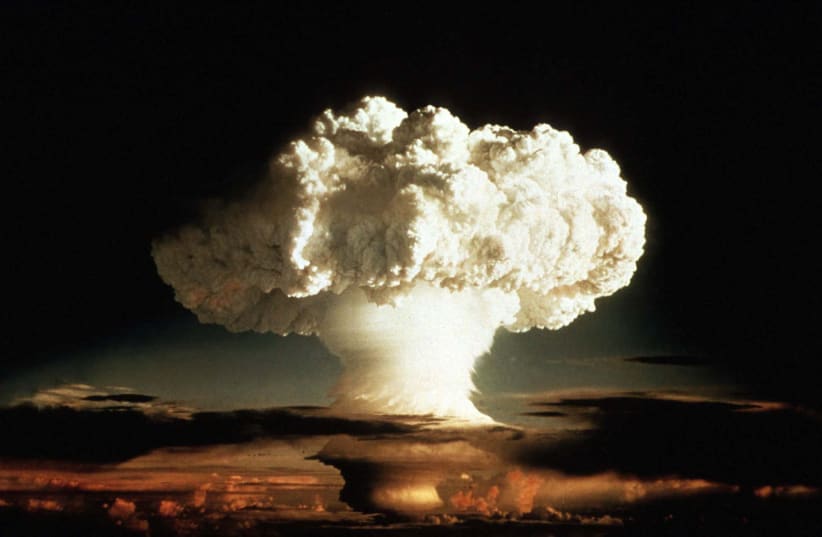Friday is not just “Barbie” release day — moviegoers are also planning to fill theaters across the United States to see Christopher Nolan’s “Oppenheimer” biopic.
Many hope it will answer a question that has long divided Americans and the country’s understanding of its history: Who exactly was J. Robert Oppenheimer, the father of the atomic bomb?
Oppenheimer’s name has become “a metaphor for mass death beneath a mushroom cloud,” in the words of Kai Bird and Martin J. Sherwin, whose 2005 book “American Prometheus” was adapted into Nolan’s film. But to fully understand the physicist, biographers have looked for clues in his belief system — an ethical code grounded in science and rationality, a fiery sense of justice and a lifelong ambivalence toward his own Jewish heritage.
Here’s a primer on his Jewish story, the other Jewish characters he met while developing the Manhattan Project and how the movie portrays it all.
The German Jew who was “neither German nor Jewish”
Oppenheimer was born in 1904 to German Jewish parents rapidly rising into Manhattan’s upper class. His father, Julius Oppenheimer, came from the German town of Hanau and arrived in New York as a teenager — without money or a word of English — to help relatives run a small textile import business. He worked his way up to full partner, won a reputation as a cultured fabrics trader and fell in love with Ella Friedman, a painter whose German-Jewish family had settled in Baltimore in the 1840s.


Their secular household embraced American society. The Oppenheimers never went to a synagogue or had a bar mitzvah for their son; instead, they aligned themselves with the Ethical Culture Society, an offshoot of Reform Judaism that rejected religious creed in favor of secular humanism and rationalism. Oppenheimer was sent to the Ethical Culture School in New York’s Upper West Side, where he developed an interest in universal moral tenets and a firm distance from Jewish traditions.
Although his parents were first- and second-generation German immigrants, Oppenheimer always insisted that he didn’t speak German, according to Ray Monk, the author of “Robert Oppenheimer: A Life Inside the Center.” He also maintained that the “J” in “J. Robert Oppenheimer” stood for nothing at all — even though his birth certificate read “Julius Robert Oppenheimer,” indicating his father had passed on the Jewish name.
“To the outside world, he was always known as a German Jew, and he always insisted that he was neither German nor Jewish,” Monk told the Jewish Telegraphic Agency. “But it affected his relationship with the world that that is how he was perceived.”
Oppenheimer’s academic brilliance became a flimsy shield against the antisemitism that orbited his life. He entered Harvard just as the university moved toward a quota system over concerns about the number of Jews being admitted. Nonetheless, he kept to his studies and stayed aloof from the campus controversy, according to Monk. He even tried to befriend non-Jewish students, but the prevailing antisemitism mostly doomed those efforts and left him with a predominantly Jewish friend group.
After earning a bachelor’s degree from Harvard in 1925, he conducted research at the University of Cambridge’s Cavendish Laboratory and completed his PhD at Göttingen University — in pre-Nazi Germany — under Max Born, a pioneer of quantum mechanics. Before he got to Cambridge, though, a Harvard professor wrote him a recommendation that captured the institutionalized prejudice in academia: “Oppenheimer is a Jew, but entirely without the usual qualifications.”
Oppenheimer returned from Europe to teach physics at the California Institute of Technology and the University of California at Berkeley. While at Berkeley, he tried to secure a position for his colleague Robert Serber and was rebuffed by his department head Raymond Birge, who said, “One Jew in the department is enough.” He did not push back on the decision, later hiring Serber to work on the Manhattan Project.
The Nazi effect on scientific development
Until the 1930s, Oppenheimer was resolutely indifferent to politics. Though he studied Sanskrit along with science and read classics, novels and poetry, he took no interest in current affairs. He later explained this at his infamous 1954 hearing before the United States Atomic Energy Commission — which, at the height of the McCarthy era, would end with him losing his security clearance over past associations with communists and support for left-wing causes.
“I was almost wholly divorced from the contemporary scene in this country,” he said. “I never read a newspaper or a current magazine like Time or Harper’s; I had no radio, no telephone; I learned of the stock market crash in the fall of 1929 only long after the event; the first time I ever voted was in the presidential election of 1936.”
But a profound shift occurred in Oppenheimer during the mid-1930s, as he watched family, friends and great scientific minds crushed under the tides of Nazism in Germany and the economic collapse at home.
“I had a continuing, smoldering fury about the treatment of Jews in Germany,” he said in his testimony. “I had relatives there, and was later to help in extricating them and bringing them to this country. I saw what the Depression was doing to my students… And through them, l began to understand how deeply political and economic events could affect men’s lives.”
In addition to rescuing family members, while teaching at Berkeley, he earmarked 3% of his salary to help Jewish scientists escape Nazi Germany. By World War II, his drive to defeat Germany would propel him to direct the Manhattan Project — the top-secret development of an American atomic bomb — at the Los Alamos Laboratory in New Mexico.
He was an unlikely candidate for the post. The FBI had already marked him as politically suspect for communist sympathies. He was a theoretical scientist, not an applied scientist with experience leading a laboratory. He wasn’t yet 40 years old. But Lieutenant Colonel Leslie Groves chose Oppenheimer as the Manhattan Project’s director in 1942 partly because he showed a burning sense of imperative.
“Oppenheimer said to Groves, ‘Look, the Nazis will have their own bomb project and it will be led by Heisenberg, who’s one of the leading nuclear physicists in the world. We need to move and we need to move quickly,’” said Monk.
Other prominent Jewish scientists felt compelled to join. Six of the project’s eight leaders were Jewish, along with a significant number of Jewish technicians, scientists and soldiers up and down the ranks, some of them refugees from Europe.
The Strauss feud
Although two atomic bombs ultimately dropped on the Japanese cities of Hiroshima and Nagasaki, not Germany — and Germany had already surrendered by then — Oppenheimer was hailed as a hero for his role in ending World War II.
But only nine years later, he was humiliated before the Atomic Energy Commission and stripped of his security clearance. Lewis Strauss, the chairman of the AEC, became suspicious of Oppenheimer for opposing the development of a hydrogen bomb. Oppenheimer pressed for international control of nuclear weapons, believing the purpose of the atomic weapon was to end all war.
But Strauss had a different objective: US supremacy over the Soviet Union.
“Oppenheimer said you’d have to be crazy to use a weapon that was 1,000 times more powerful than the bomb that destroyed Hiroshima. So his case was, ‘We can’t develop this thing,’” said Monk. “Lewis Strauss was inclined to think that the only person who would advocate the US not developing a hydrogen bomb was somebody who had the interests of the Soviet Union at heart.”
Strauss also developed a personal hatred for Oppenheimer, who could be arrogant and supercilious. They came from very different Jewish backgrounds: Strauss was a committed Reform Jew with modest origins, who worked as a traveling shoe salesman instead of going to college. He identified closely with his faith and served as the president of New York’s Temple Emanu-El from 1938 to 1948.
“I think Strauss also had to navigate being Jewish in an American society that didn’t totally embrace Jews, and I think it was somewhat of a threat to him to have somebody like Oppenheimer whose approach to dealing with his Judaism was to hide it, basically,” physicist and rabbi Jack Shlachter told the Jewish Telegraphic Agency.
In the film, Strauss is portrayed as having secretly orchestrated Oppenheimer’s downfall at the hands of the Atomic Energy Commission, in part by collaborating with Hungarian-Jewish physicist Edward Teller, who agreed with Strauss on the necessity of the hydrogen bomb.
How Nolan’s film portrays the story’s several Jewish characters
Bird writes an account of Oppenheimer running into Albert Einstein, one of the most famous Jewish figures of the 20th century, shortly before the 1954 hearing. The two men were friends and colleagues at Princeton’s Institute for Advanced Study; Einstein joined the faculty after fleeing Nazi Germany in 1933, while Oppenheimer became the institute’s director in 1947.
Einstein had signed a letter to President Franklin Delano Roosevelt, written by physicist Leo Szilard, that urged the development of a fission bomb in 1939. Einstein later regretted signing it.
According to Bird, Einstein urged his friend not to go before the AEC. He said that Oppenheimer had already done his duty for America, and if the country repaid him with a witch hunt, he “should turn his back on her.”
Oppenheimer’s secretary Verna Hobson, who witnessed the conversation, said he could not be dissuaded. “He loved America,” she said, “and this love was as deep as his love of science.”
Einstein responded by calling Oppenheimer a “narr,” or “fool” in Yiddish.
The movie makes considerable hay out of Oppenheimer’s relationship with Einstein, played by Scottish actor Tom Conti. The two men have frequent run-ins both during and after the development of the bomb.
Another Jewish physicist friend and colleague, Isidor Rabi, attributed Oppenheimer’s lifelong loneliness and bouts of depression to the distance he created from other Jews — a community that might have given him some solace from his own government’s rejection.
“Isidor Rabi said that his problem was that he couldn’t identify fully as Jewish,” said Monk. “Although Rabi wasn’t religious, when he saw a group of Jews, he said, ‘These are my people.’ And Oppenheimer could never do that.”
In the film, characters repeat Oppenheimer’s insistence that the “J” stands for “nothing,” rarely interrogating him on his Judaism. He never encounters any overt antisemitism directed at him. Yet the movie’s version of Oppenheimer, played by Irish actor Cillian Murphy, does not seem as tortured by his Jewish identity as Rabi said he was in real life. At several points in the film, Oppenheimer bonds with other characters in his orbit over their Judaism and expresses anger at Hitler’s treatment of German Jews.
The film’s Oppenheimer also claims to read German well, including the ability to read Karl Marx’s “Das Kapital” in its original language. It’s part of the character’s lifelong fascination with languages, which also informs his famous utterance of the Bhagavad Gita quote, “Now I am become Death, destroyer of worlds.”
The only language the film’s Oppenheimer seems to have no interest in learning is Yiddish — a fact that Rabi (played by Jewish actor David Krumholtz) ribs him about at their first meeting in prewar Germany, when Rabi tries to bond with Oppenheimer over feeling like their kind isn’t welcome.
In the movie, Oppenheimer is also shown welcoming multiple Jewish refugee physicists to the Manhattan Project facility. Teller, played by Jewish actor Benny Safdie, is one of them, even though he becomes a key adversary.
As for Strauss’ character, played by Robert Downey Jr., he proudly mentions his key Jewish resume point early on in the film.
“I’m the president of Temple Emanu-El in Manhattan,” he exclaims.
